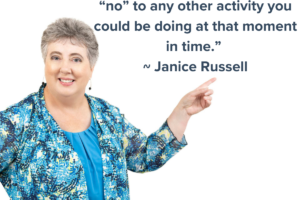
Create a Morning Routine that Works – even if you’re not a morning person!
Where are you on the “morning spectrum”?
- Love it. Favorite time of the day. Get lots done.
- Hate it. Would love to never see morning. No energy.
- Neutral. Take it or leave it. Energy is fine. Like evening as well.
Regardless of where you are on the “morning spectrum,” it’s likely that you have responsibilities that start in the a.m.
So what do you do to get your day started off well?
Did you immediately list all of the things you do to successfully begin your day? Or did you think, “I start off behind and it’s downhill from there!”
Morning habits…we all have them. How smoothly your routine flows can determine how well the rest of your day goes. So let’s explore some ways to simplify your routine and get your day off to a great start (even if you don’t happen to be a morning person).
First, determine what has to be done in the morning.
Let me start with an example. For years when I had a job with regular hours, I got up, had prayer time, went to work, and then exercised in the evening. When my work schedule changed, I got up, exercised, had prayer time, and then went to work.
Then things went awry! When I started my business, my schedule became more flexible. I stopped the morning exercise habit, thinking that I could work out any time of the day. Boy, once you stop a habit, it’s mighty difficult to get it started again!
I realized that if I didn’t exercise in the morning, it wasn’t going to happen. Yet, I kept getting stuck.
At that time, my cat woke me up at 5:30 a.m. for breakfast. After feeding her, I would have prayer time and then…while it was my intention to go to the gym, invariably it didn’t happen.
I finally had an epiphany! If I put on workout clothes prior to feeding my cat, then I could drive straight to the gym. That simple change (dressing before going downstairs) made a big difference…for awhile before I got derailed again.
What finally got me back into a consistent exercise habit? The pandemic!
With online meetings, I saved drive time. I turned this into walking time. I started small and found that I really enjoyed being out in nature. I also discovered that it helped manage my depression to the point when I got to decrease the dosage of one medication.
Now you may be thinking, “Janice, what does this have to do with me?”
Well, you have to decide what has to be done in the morning and what can be done some other time. Now clearly, you have to change from pajamas into clothes and brush your teeth, but otherwise, there are lots of options.
Here are a few to consider:
- News: whether you prefer to watch, listen, or read, with the 24-hour news cycle, finding out the latest doesn’t have to happen in the morning.
- Clothing choices: can be done the evening before or on Sunday for the whole week.
- Packing lunch: get as much as possible ready the night before and have all perishables in one place in the refrigerator for easy access.
- Trash/recycling: put out the night before.
- Other tasks: you decide which ones can only be done in the a.m.
Second, designate non-negotiables.
Great! Now you know what you plan to do in the morning versus deferring to another time in the day.
But wait!
You need a Plan B because there are days when the alarm fails to go off, you hit the snooze button too many times, you need to be at work earlier than usual, or your pet leaves you a “gift” in the middle of the floor. So how do you deal with changes in your schedule?
You establish your non-negotiables. For instance, while you prefer to get the latest news update in the morning, if you get into a time crunch, that is something that could be put off until later in the day, whereas getting dressed is usually required. Even if you have Zoom meetings, you have to be presentable from the waist up.?
If you’re short on time, you may decide to go out to lunch rather than packing one. But if you have specific food requirements and it’s difficult to eat out, packing a lunch might be non-negotiable.
My non-negotiable is related to email. It’s easy to say, “I’ll just check my email quickly. It won’t take any time at all.” Next thing I know, it’s time to leave and I haven’t taken a shower. So I determined that I have to be totally ready to go before I check email. Even then, I set a timer to make sure I’m leaving when I should.
Another part of Plan B can be altering a non-negotiable. So while exercising is a non-negotiable to me, if I’m pressed for time, there are ways that I can shorten my workout without sacrificing it altogether.
Third, decide which habit to change first. Bottom-line is that we’re talking about replacing your current (non-functioning) habits with functional ones. The most effective way to do this is SLOWLY. That means choose one small step and work on it for 20-60 days until it is an ingrained pattern.
Maybe overall you’ve decided to choose your clothes and pre-pack lunch in the evening. You could start by getting out the lunch bags and putting a napkin inside. That might be all you do for several weeks. Then for a few weeks after that, you also put the non-perishables in the lunch bags. Finally, you start placing the perishables in a specific spot in the refrigerator. Yes, it seems like a long time to form what sounds like an easy habit. But if it was that easy, why weren’t you doing it already?
What is one small change that would simplify your morning routine?
Typing your “one very small change” in the comments below will make you more likely to take action!



